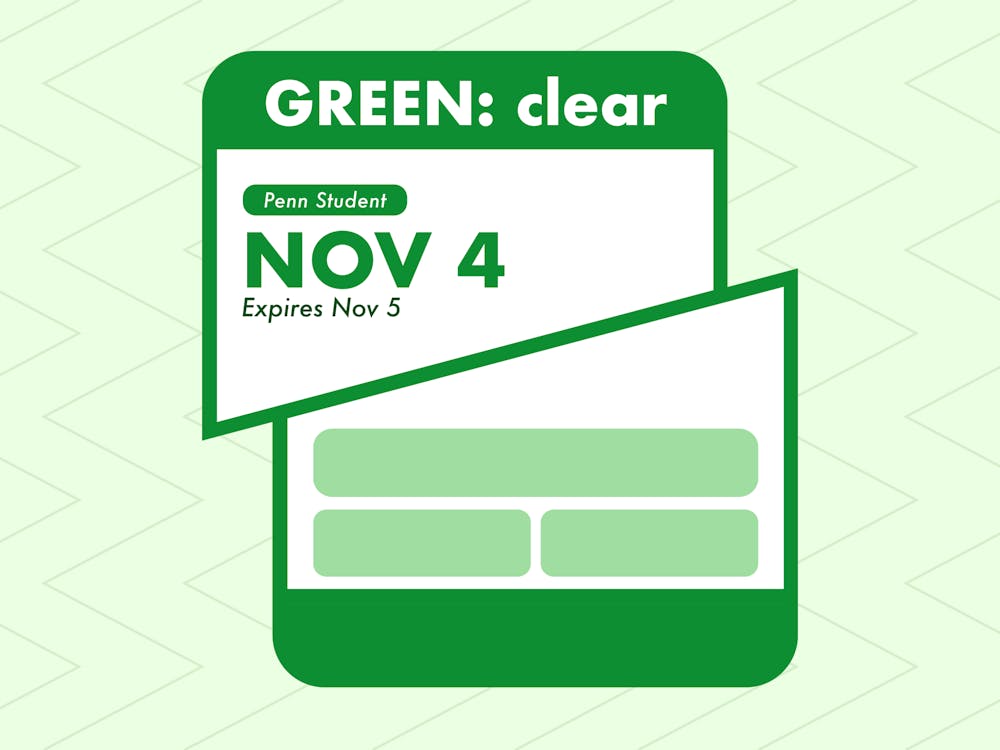
Penn reached an impressive milestone recently. 99% of undergraduate students are fully vaccinated. With a 0.31% positivity rate, one would consider Penn to be a relatively COVID-safe campus.
For the most part, campus has returned to normal. Crowds of maskless students walk down Locust every day, a sight that was only common during pre-pandemic life. Parties and other social events are being held with minimal to no restrictions. But, one part of campus life remains as a reminder that we are not yet in a post-pandemic world: PennOpen Pass.
Sometime during this semester, you have probably entered a building without hesitation and been told by security, “Open Pass.” After hearing these two words, you quickly begin to fill out the questionnaire. You check the usual boxes in the familiar sequence: no, no, no symptoms, no. Your screen lights up with big green letters, and you’re allowed to continue about your day.
According to the How-to Guide for PennOpen Pass, “It is recommended that members of the Penn community complete their symptom and exposure check an hour or two hours before the start of the work or school day.” In reality, that is not the case. Walk into Van Pelt Library or one of the campus buildings that require PennOpen Pass and it is common to see students standing in the lobby filling out their daily symptom check. At that point, students have already made the decision to enter that building. In fact, they have already entered that building. There is no incentive to be truthful in their responses.
The How-to Guide further says, “As of Aug. 25, all University faculty, staff, postdocs, and students are required to use PennOpen Pass every day, including weekends and regardless of vaccination status.” There is no effective enforcement or maintenance of this so-called requirement. A system like PennOpen Pass can only be successful if it relies on consistent use, meaning every building requires it for entry.
Even though more buildings, such as Houston Hall, are beginning to require PennOpen Pass, that is not enough. The choice of buildings that will require PennOpen Pass seems arbitrary. Dining halls, arguably the most high-risk COVID-19 transmission areas, do not make the cut, yet Perry World House does.
If the non-compliance testing situation was any indication, the PennOpen Pass system is deeply flawed, not in its issuance of 9,130 red passes, but in the fact that students were allowed to attend in-person classes and enter campus facilities with those red passes. And then, this week, a number of people I know got non-compliance red passes again but continued entering buildings because the passes were not being checked.
The How-To Guide continues, “Across campus, individual Schools and Centers may require a Green Pass for building entry.” Penn prides itself on being an interdisciplinary school. Students travel across disciplines, both figuratively and literally, as they move across campus. However, schools are told to act independently as to how COVID-19 protocols should be enforced, or lack thereof. How has that made Penn as a whole any safer?
For example, you must have a green pass to be in any Wharton building. Yet, you can walk into Huntsman, Steinberg-Dietrich or the Academic Research Building without showing PennOpen Pass. Even the messaging within individual schools is unclear.
At Columbia, students are required to show green passes for entry into all campus buildings. At Harvard, students are not required to fill out a daily symptom check but rather only if they experience symptoms, potential exposure or test positive. It is not impossible to imagine PennOpen Pass working in either of those ways: as a preventative measure with complete standardization or as a responsive measure once a COVID-related issue arises. Other Ivy League universities have done it. Yet, Penn wants to have it both ways with partial standardization. By getting rid of a PennOpen Pass as a preventative measure, our lives will be made simpler at no evident cost.
Successful implementation of PennOpen Pass is about strategy. If Penn wants students to complete daily symptom checks, they should require proof of a green pass for entry into every building. Students will be incentivized to complete PennOpen Pass daily because, in return, they are guaranteed access to every campus building. When there is little risk of denial from buildings, there is little incentivization to complete PennOpen Pass. But, it does not seem Penn is willing to do that.
There is no clear benefit to partial implementation of PennOpen Pass. It is all or nothing. I choose nothing.

YOMI ABDI is a Wharton first year studying finance from Chicago. Her email is yomiabdi@wharton.upenn.edu.
The Daily Pennsylvanian is an independent, student-run newspaper. Please consider making a donation to support the coverage that shapes the University. Your generosity ensures a future of strong journalism at Penn.
Donate




